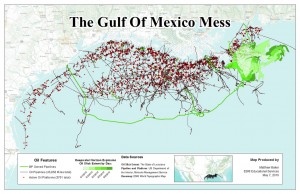Ko pat zinātnieki baidās teikt par Meksikas līča naftas noplūdi
Autors egleskoks @ 16 jūnijs, 2010
Lasot www.lifeaftertheoilcrash.net, uzdūros saitei uz rakstiņu Globalresearch.ca, kas saucas “What US Scientists Are Forbidden To Tell The Public About The Gulf“, savukārt pārpublicēts no rense.com. Mēģinot to atvērt uz globalreserch.ca, rakstiņš ir dzēsts. Kas liek domāt, ka tur tiešām kaut kas interesants ierakstīts, tāpēc sameklēju to Gūgles kešā. Un tik tiešām, tur stāstītais paredz visai nepatīkamas sekas. Pareizāk sakot, ļoti nepatīkamas.
Tālāk īss pārstāsts latviešu valodā, ar sekojošu oriģinālrakstu angliski, lai tautieši var izlasīt.
==========================

Naftas platformas un naftas noplūde Meksikas līcī, karte. Avots: http://www.flickr.com/photos/50065183@N06/4593362250/
Meksikas līcī nafta noplūst ar ātrumu 80 – 100 tūkstoši barelu dienā. Naftas barels ir apmēram 159 litri, tātad tie ir vismaz 12720 kubukmetri jēlnaftas dienā. Spiediens, ar kādu nafta plūst ārā no urbuma, ir no 20,000 līdz 70,000 PSI, kas atbilst 1360-4760 atmosfērām (vieglā automobiļa riepā ir 2-3 atmosfēras, maģistrālajos gāzes vados līdz kādām 70 atmosfērām). Šādu spiedienu ir grūti savaldīt un ierobežot.
Naftas urbumā ir ievietota metāla caurule, 2 collas (apmēram 5 cm) bieza. Naftai izplūstot no urbuma, tā rauj līdzi smilšu un iežu daļiņas, kas darbojas kā smilšpapīrs, urbuma cauruli no iekšpuses beržot arvien plānāku. Lēš, ka atlikusi tikai puse no caurules biezuma.
Izplūdusī nafta jau ir sasniegusi straumes Atlantijas okeānā, kas naftu iznēsās pa visu Atlantijas okeānu, ieskaitot Eiropas krastus, un 18 mēnešu laikā pa visu pasauli. Pasaules okeāna straumju karti var aplūkot šeit.
Un tagad prognoze. Naftas plūsmu nav iespējams apturēt principā, jo pat aizbāžot urbuma cauruli no gala, tā pārplīsīs lejāk, jo ir nodilusi no iekšpuses un netur spiedienu. Kad no caurules vairs nebūs palicis nekas, plūstošā nafta urbumu paplašinās, izskalojot sienas, līdzīgi kā sūce dambī ātri izrauj tajā milzīgu robu. Tas nozīmē, ka naftas plūsma paātrināsies, iespējams, pat vairākas reizes. Kopējais noplūdušais daudzums – daži miljardi barelu (1 miljards barelu-15,9 miljoni kubukmetru) naftas.
Noplūdušajā naftā esošie savienojumi reaģē ar ūdenī izšķīdušo skābekli, veidojot anaerobus apstākļus. Nafta arī satur daudzas dzīvajiem organismiem toksiskas vielas. Šis saindētais, bezkābekļa ūdens lielā daudzumā ieplūdīs Atlantijas okeānā, Meksikas līcis būs pamatīgi saindēts ar dažādiem organiskiem savienojumiem.
Kad tieši noplūde beigsies, izsīkstot naftai, ir grūti paredzēt. Kad spiediens naftas urbumā izlīdzināsies ar spiedienu okeāna dibenā, urbumā lēnām ieplūdīs ūdens un aizvietos naftu. Naftas iegulas atrodas dziļumā, kur temperatūra ir apmēram 200 Celsija grādi.
======================
Tālāk autori spekulē, ka ieplūdušais ūdens uzkarsīs, sāks vārīties un izpletīsies, izsaucot zemestrīces un cunami, kas piesārņoto ūdeni ietrieks 50 jūdzes (80 km) no krasta līnijas sauszemē. Sliecos šo scenāriju apšaubīt, jo:
1) Naftas iegulas nav milzīgi dobumi zem zemes, drīzāk poraini ieži, kas piesūkušies ar naftu kā sūklis ar ūdeni; tāpēc strauja ūdens ieplūšana un lielu masu uzkaršana nav iespējama, nav pietiekamas spiedienu starpības;
2) Ūdens vārīšanās temperatūra atkarīga no spiediena, augstkalnu apstākļos tas vārās ar 80 Celsija grādu temperatūrā, un ūdens tvaika spiediena kritiskais punkts ir pie 374 Celsija grādiem un 217 atmosfērām. Ieplūdušais ūdens ātri uzkarsīs nelielos daudzumos un tvaiki dosies augšup.
Visdrīzāk, radīsies kaut kas līdzīgs zemūdens geizeram, kas periodiski izvirdīs tvaika un naftas maisījumu ilgāku laiku.
Taču jebkurā gadījumā, liela naftas daudzuma noplūde ir visai nepatīkama lieta, un sekas -nopietnas.
Te var apskatīties karti ar naftas plankumu kartē, un te arī.
==========================
| Global Research, June 14, 2010 | |||||
| Rense – 2010-06-09 | |||||
| Email this article to a friend Print this article | |||||
|
|||||
| It has been estimated by experts that the pressure which blows the oil into the Gulf waters is estimated to be between 20,000 and 70,000 PSI (pounds per square inch). Impossible to control.
What US Scientists Are Forbidden To Tell The Public About The Gulf What you are about to read, is what the scientists in the United States are not allowed to tell you in great fear of the Obama administration. They are under the threat of severe repercussions to the max.. Scientists confirming these findings cannot be named due to the above, but what they believe, they want to be known by all. Take a U. S. map, lay it flat and measure inland just the minimum 50 miles of total destruction all around the Gulf of Mexico as to what you will read below. The carnage to the United States is so staggering, it will take your breathe away. Should what the scientists who are trying to warn everyone about be even close to being true… all of Florida will be completely destroyed as will everyone and everything on it. You decide!! Everyone has the right to read what I have just written in this article, as well as to what is written below by the scientists who the Obama administration and BP are trying to shut up. Please share with as many as you can. –Dr. James P. Wickstrom http://graphics8.nytimes.com/images/2010/05/05/learning/oilslickLN/oilslickLN-blogSpan.jpg Summary of What is Happening The estimated super high pressure release of oil from under the earth’s crust is between 80,000 to 100,000 barrels per day. The flow of oil and toxic gases is bringing up with it… rocks and sand which causes the flow to create a sandblasting effect on the remaining well head device currently somewhat restricting the flow, as well as the drilled hole itself. As the well head becomes worn it enlarges the passageway allowing an ever-increasing flow. Even if some device could be placed onto the existing wellhead, it would not be able to shut off the flow, because what remains of the existing wellhead would not be able to contain the pressure. The well head piping is originally about 2 inches thick. It is now likely to be less than 1 inch thick, and thinning by each passing moment. The oil has now reached the Gulf Stream and is entering the Oceanic current which is at least four times stronger than the current in the Gulf, which will carry it throughout the world within 18 months. The oil along with the gasses, including benzene and many other toxins, is deleting the oxygen in the water. This is killing all life in the ocean. Along with the oil along the shores, there will be many dead fish, etc. that will have to be gathered and disposed of. Summary of Expectations At some point the drilled hole in the earth will enlarge itself beneath the wellhead to weaken the area the wellhead rests upon. The intense pressure will then push the wellhead off the hole allowing a direct unrestricted flow of oil, etc. The hole will continue to increase in size allowing more and more oil to rise into the Gulf. After several billion barrels of oil have been released, the pressure within the massive cavity five miles beneath the ocean floor will begin to normalize. This will allow the water, under the intense pressure at 1 mile deep, to be forced into the hole and the cavity where the oil was. The temperature at that depth is near 400 degrees, possibly more. The water will be vaporized and turned into steam, creating an enormous amount of force, lifting the Gulf floor. It is difficult to know how much water will go down to the core and therefore, its not possible to fully calculate the rise of the floor. The tsunami wave this will create will be anywhere from 20 to 80 feet high, possibly more. Then the floor will fall into the now vacant chamber. This is how nature will seal the hole. Depending on the height of the tsunami, the ocean debris, oil, and existing structures that will be washed away on shore and inland, will leave the area from 50 to 200 miles inland devoid of life. Even if the debris is cleaned up, the contaminants that will be in the ground and water supply will prohibit re-population of these areas for an unknown number of years. (End of scientists information release.) From Tom Buyea FL News Service |
|||||
| Global Research Articles by James P. Wickstrom | |||||
Piebilde 16. septembrī. Ja ar naftas nolūdēm nedara neko, nafta parasti sadaloties dažu mēnešu laikā. Viens no piemēriem ir Līča karš, kad karadarbības rezultātā ar naftu piegāza piejūras zemienes. Dažu mēnešu laikā naftu noārdīja mikroorganismi, un pēc gada- diviem ekosistēmas bija apmēram tikpat tīras kā pirms tam. Vislielākie mēsli rodoties, kad naftas piesārņojumu mēģina mazināt vai slēpt ar krietni indīgāku ķimikāliju palīdzību, kā to šoreiz darīja British Petroleum, izmantojot kokteili ar nosaukumu Corexit – baumo, ka tas ir indīgs atkritumprodukts, kuru atjautīgi cilvēki reģistrējuši kā disperģentu; ražotājs Nalco ir saistīts ar British Petroleum, Corexit 9500 sastāvā ir naftas destilācijas produkti vai butoksietanols (Corexit 9527A), pēdējais ir stipri indīgs cilvēkiem, lai arī samērā ātri noārdās vidē (mēneša, divu laikā).
Kas attiecas uz baumām, ka Golfa straume stājas tieši šīs naftas noplūdes dēļ, atļaušos pasmieties. Visticamāk, tam ir citi iemesli, saistīti ar Saules ietekmi un citiem vareniem spēkiem, ja tā tik tiešām stājas. Ziemā redzēsim, kam ir taisnība.


17 jūnijs, 2010 15:18
Super lai tik dod valjaaa! Nafta power!
17 jūnijs, 2010 16:56
skērī šit!
nav ko piebilst.
16 septembris, 2010 13:03
Latvijā arī visi naftas atradumi janovieto tik uz sauszemes, ja negrib problēmas !!!
13 janvāris, 2022 04:06
1protocols…
…